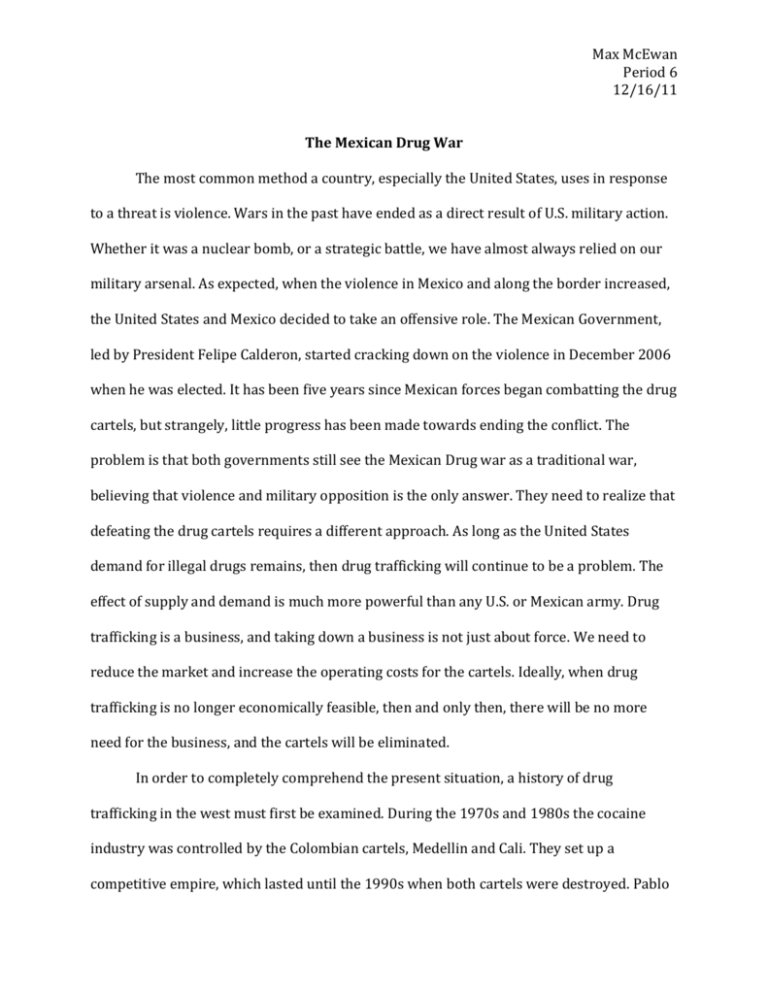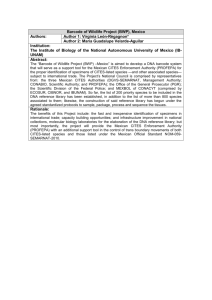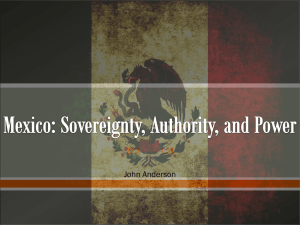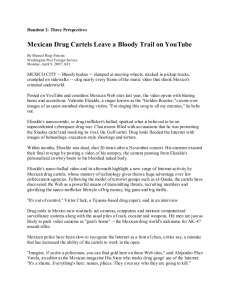Max McEwan Period 6 12/16/11 The Mexican Drug War The most
advertisement

Max McEwan Period 6 12/16/11 The Mexican Drug War The most common method a country, especially the United States, uses in response to a threat is violence. Wars in the past have ended as a direct result of U.S. military action. Whether it was a nuclear bomb, or a strategic battle, we have almost always relied on our military arsenal. As expected, when the violence in Mexico and along the border increased, the United States and Mexico decided to take an offensive role. The Mexican Government, led by President Felipe Calderon, started cracking down on the violence in December 2006 when he was elected. It has been five years since Mexican forces began combatting the drug cartels, but strangely, little progress has been made towards ending the conflict. The problem is that both governments still see the Mexican Drug war as a traditional war, believing that violence and military opposition is the only answer. They need to realize that defeating the drug cartels requires a different approach. As long as the United States demand for illegal drugs remains, then drug trafficking will continue to be a problem. The effect of supply and demand is much more powerful than any U.S. or Mexican army. Drug trafficking is a business, and taking down a business is not just about force. We need to reduce the market and increase the operating costs for the cartels. Ideally, when drug trafficking is no longer economically feasible, then and only then, there will be no more need for the business, and the cartels will be eliminated. In order to completely comprehend the present situation, a history of drug trafficking in the west must first be examined. During the 1970s and 1980s the cocaine industry was controlled by the Colombian cartels, Medellin and Cali. They set up a competitive empire, which lasted until the 1990s when both cartels were destroyed. Pablo Escobar, the leader of the Medellin cartel, was an extremely violent person, thought to be responsible for the murder of hundreds of government officials, police, prosecutors, judges, journalists and innocent bystanders (The Business). The downfall of the Colombian cartels opened the stage for Mexican cartels to take the lead in drug trafficking. Presently, Colombian cartels are very small and do not have much power. “Before, the Colombian cartels told Mexicans what price they would pay for wholesale cocaine. Now, Mexican gangs play smaller Colombian suppliers off of each other to get the best price. Mexican gangs are ‘price setters’ instead of ‘price takers.’” (Luhnow) There has been a violent struggle between drug cartels since the collapse of Medellin and Cali. Today, the seven drug cartels in Mexico are: Sinaloa Cartel, Tijuana Cartel, Juarez Cartel, Gulf Cartel, La Familia Michoacana, Los Zetas, and Beltran Levya Organizations (Senate Caucus 19). Standing out, as the most violent and powerful cartels, are the Sinaloa Cartel and Los Zetas. Some of these cartels are peaceful and cooperative with each other, while others are extremely violent against each other. Why is trafficking so popular despite the risks? According to Ioan Grillo, Author of El Narco, "You can buy a kilo brick of cocaine in Colombia for $2,000. When you sell it at a gram level in the U.S., you can turn that into some $100,000". Grillo, having spent time in Mexico, was able to observe the cartels first-hand (El Narco). This supports the fact that drug trafficking is a high-rewarding business opportunity. It is understandable how a poor Mexican farmer can be drawn into the business in hopes of making money. “Illegal drugs are the most successful Mexican multinational enterprise, employing some 450,000 Mexicans and generating about $20 billion in sales” (Luhnow). “Forbes magazine put Mexican drug lord Joaquin ‘Shorty’ Guzman as No. 701 on the world's list of billionaires” (Luhnow). Extremely high profits 2 allowed the cartels to have better technology, higher efficiency, better security, and ultimately more power. According to Ioan Grillo, “Traffickers used gangbangers to carry out their assassinations — but not anymore. Now they have fully fledged militias with AK47s, [rocket-propelled grenades], and they have become something very fearsome and very dangerous within Mexico” (El Narco). Like any good business, Mexican drug cartels adapt and innovate to different situations, especially with all of the money they have. A recent drug bust involved “a shipment of liquefied cocaine smuggled in red wine bottles” (Luhnow). Another bust yielded cocaine stuffed inside a batch of frozen sharks. Why have current solutions been unsuccessful? One of the main reasons why enforcement has failed is because of corruption. Georgetown University’s Daniel Sabet says, “While law enforcement should be the primary tool to advance the country’s crime problems, the police are viewed as part of the problem rather than part of the solution” (Senate Caucus 32). As of March 2010, there have been 3,400 complaints against Mexican military personnel. It seems that Mexican enforcement is being enticed by the abundance of cash too. In fact, the corruption and disorder has gotten so bad that currently only “1.55 percent of suspected crimes in Mexico result in convictions”. The U.S. has a 90.3 percent conviction rate. (Senate Caucus 33) As mentioned before, a different approach is needed to eradicate the drug cartels. We need a strategy to strike them where it hurts. One possible solution that is expected to have beneficial results is to legalize marijuana in the United States. “Marijuana accounts for 50% to 65% of Mexican cartel revenues” (Luhnow). The four drugs that are trafficked into the United States through Mexico are marijuana, cocaine, heroin, and methamphetamine. Cocaine has the highest profit margin, but they sell the most marijuana. 96% of marijuana 3 seized in the U.S. is seized at the Southwest border (Luhnow). The legalization of marijuana in the United States would almost completely diminish the marijuana demand from Mexico. The U.S. would grow the majority of its marijuana in California because it is closer to the consumers and is grown more efficiently. It is predicted that there would be increased violence in Mexico at first because the cartels would fight to control the other three drugs. Long-term predictions show an overall decrease in violence. With marijuana no longer a source of revenue, the drug cartels would be less prosperous and powerful. To cartels, marijuana is a constant source of income that they use to fund other things. Without that constant flow of money, the cartels may struggle to keep the industry going. It would definitely be a heavy hit to their business. It also needs to be clear that decriminalization and legalization do not accomplish the same goal. States like California and Oregon have decriminalized marijuana possession for small amounts. The main goal of this is to prevent overcrowded jails. Drug dealing is still illegal, so consumers are obligated to continue buying from Mexico. This has a negative effect as the demand increases because there is no risk of jail time, but the Mexican supply, responsible for the violence, increases too (Luhnow). Another proposed solution that is already in effect is Mexican officials monitoring the border into Mexico. The idea behind this plan is to confiscate any large quantities of cash or weapons that are passing from the U.S. into Mexico. When drugs from Mexico are sold in the U.S., cash or guns are brought back to the cartels as payment. Instead of stopping the drugs going into the U.S., the cash going out can be stopped too. If this is successful, it will hopefully begin to economically starve the cartels (Luhnow). The Mexican government 4 also began taxing and investigating cash deposits greater than $1,250 into bank accounts. Several cases have involved cash deposits of over $4 million (Luhnow). In the 1980s and 90s the U.S. firmly restricted the travel of cocaine from Colombia through the Caribbean and into the U.S. This moved the trade to the second best passage, Mexico. Some people say that the U.S. should ease up on the trade through the Caribbean to take some pressure off of Mexico. (Luhnow) Some recent news regarding the situation involves Mexican drug cartels recruiting children in Texas to take part in the smuggling process. Steven McCraw, director of the Texas Department of Public Safety said that “six Mexican drug gangs -- including the violent Zetas -- have command and control centers in Texas actively recruiting children for their operations, attracting them with what appears to be easy money for doing simple tasks.” Earlier this month and arrest was made of a “12-year-old boy who was in a stolen pickup truck with 800 pounds of marijuana”. Plans have been made to institute “Operation Detour”, which involves law enforcement going to schools and warning children and parents about the recruitment that is happening. (Forsyth) To protect the safety of Mexico and the younger generation in the United States, our government and the Mexican government need to make some serious changes to the way we are handling the situation. Those decisions need to be smart because we are dealing with very smart drug lords. Economics is required to sway the supply and demand effect in our favor. If we can make drug trafficking economically impractical, then the drug cartels will most likely get out of the business. They are only in it for the money. Some potential solutions include the legalization of marijuana in the U.S., the confiscation of drug cash, and the close inspection of cartel finances. It is scary to see how hostile of a place Mexico has 5 become, but it is even scarier to know that the U.S. is to blame because of our drug addiction. If we are going to participate in this bad habit, then we should at least not let it harm other countries. Works Cited Archibold, Randal, Damien Cave, and Elisabeth Malkin. "Mexico’s President Works to Lock In Drug War Tactics." New York Times. 15 Oct. 2011. Web. 27 Oct. 2011. <http://www.nytimes.com/2011/10/16/world/americas/calderon-defends-militarizedresponse-to-mexicos-drugwar.html?_r=1&scp=4&sq=Mexican%20Drug%20war%20corruption&st=cse>. Burnett, John, and Marisa PEÑALOZA. "Mexico's Drug War: A Rigged Fight? : NPR." NPR : National Public Radio : News & Analysis, World, US, Music & Arts : NPR. 18 May 2010. Web. 25 Oct. 2011. <http://www.npr.org/templates/story/story.php?storyId=126890838>. "The Business - Colombian Traffickers | Drug Wars | FRONTLINE | PBS." PBS: Public Broadcasting Service. Web. 16 Dec. 2011. <http://www.pbs.org/wgbh/pages/frontline/shows/drugs/business/inside/colombian.ht ml>. "'El Narco': The Trade Driving Mexico's Drug War : NPR." NPR : National Public Radio : News & Analysis, World, US, Music & Arts : NPR. 25 Oct. 2011. Web. 25 Oct. 2011. <http://www.npr.org/2011/10/25/141650194/el-narco-the-trade-driving-mexicos-drugwar>. Ellingwood, Ken. "MEXICO UNDER SIEGE; Army's Reputation Is at Risk in Drug War; The Public May Be Losing Faith in Forces as Death Toll and Abuse Claims Rise." Log in - ProQuest - 6 ProQuest. 23 Mar. 2010. Web. 27 Oct. 2011. <http://search.proquest.com/docview/422310889?accountid=1943>. Forsyth, Jim. "Mexican Drug Cartels Recruiting Texas Children - US News - Crime & Courts Msnbc.com." Msnbc.com - Breaking News, Science and Tech News, World News, US News, Local News- Msnbc.com. 17 Oct. 2011. Web. 27 Oct. 2011. <http://www.msnbc.msn.com/id/44933451>. Luhnow, David. "Saving Mexico." The Wall Street Journal. 26 Dec. 2009. Web. 16 Dec. 2011. <http://online.wsj.com/article/SB10001424052748704254604574614230731506644.ht ml>. Thompson, Ginger. "U.S. Agencies Infiltrating Drug Cartels Across Mexico." New York Times. 24 Oct. 2011. Web. 27 Oct. 2011. <http://www.nytimes.com/2011/10/25/world/americas/united-states-infiltratingcriminal-groups-acrossmexico.html?pagewanted=1&sq=mexican%20police%20corruption&st=cse&scp=2>. United States. Cong. Foreign Affairs, Defense, and Trade Division. Mexico's Drug Cartels. By Colleen W. Cook. Cong. Rept. 16 Oct. 2007. Web. 26 Oct. 2011. <http://www.fas.org/sgp/crs/row/RL34215.pdf>. United States. Cong. Senate. U.S. SENATE CAUCUS ON INTERNATIONAL NARCOTICS CONTROL. By Dianne Feinstein and Charles Grassley. 112th Cong., 1st sess. S. Rept. Web. 25 Oct. 2011. <http://drugcaucus.senate.gov/Mexico-Report-Final-5-2011.pdf>. U.S. U.S. DEPARTMENT OF JUSTICE. NATIONAL DRUG INTELLIGENCE CENTER. National Drug Threat Assessment. Aug. 2011. Web. 25 Oct. 2011. <http://www.justice.gov/ndic/pubs44/44849/44849p.pdf>. 7 8









